Flying Machines 1/48 Re-2005
By Allan Wanta
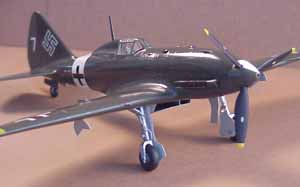 |

 |
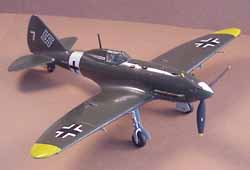 Overall the Re.2005's performance was superior to that of its direct rival, the Fiat G.55 Centauro. The only difficulty was a certain structural weakness in the rear section of the fuselage. This defect appeared in the first phases of its short operational life, and at one point all flights of this aircraft were suspended until this problem was corrected.
Overall the Re.2005's performance was superior to that of its direct rival, the Fiat G.55 Centauro. The only difficulty was a certain structural weakness in the rear section of the fuselage. This defect appeared in the first phases of its short operational life, and at one point all flights of this aircraft were suspended until this problem was corrected.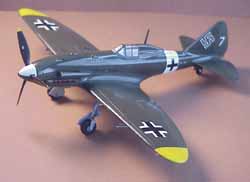 The plane's operational career begain in May 1943, when it was assigned to the 362nd Squadrigia of the 22nd Gruppo. The unit was sent to Sicily at the time of the Allied invasion. Late in June it was based in Capua and used in operations against Allied bombers until 26 August 1943. When the armistice was signed in September, many of the surviving Re.2005s were destroyed by their pilots to prevent them from falling into German hands. Mussolini's forces in the north did manage to get six of these aircraft which they used as trainers. Some aircraft (as many as 13) were captured by the Germans. Some sources maintain that these aircraft were used late in 1943 against Allied bombing raids on Berlin. Others believe that these planes were used as intercepters in defence of the Romanian oil fields. Thanks to The Flightline Aviation Archive, https://www.kotfsc.com/aircraft/main.htm, for the above history, cause I'm a model builder not a writer.
The plane's operational career begain in May 1943, when it was assigned to the 362nd Squadrigia of the 22nd Gruppo. The unit was sent to Sicily at the time of the Allied invasion. Late in June it was based in Capua and used in operations against Allied bombers until 26 August 1943. When the armistice was signed in September, many of the surviving Re.2005s were destroyed by their pilots to prevent them from falling into German hands. Mussolini's forces in the north did manage to get six of these aircraft which they used as trainers. Some aircraft (as many as 13) were captured by the Germans. Some sources maintain that these aircraft were used late in 1943 against Allied bombing raids on Berlin. Others believe that these planes were used as intercepters in defence of the Romanian oil fields. Thanks to The Flightline Aviation Archive, https://www.kotfsc.com/aircraft/main.htm, for the above history, cause I'm a model builder not a writer.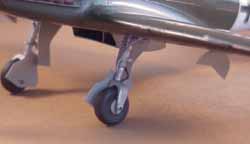 Do we have a better Re-2005 kit here? Yes and yes, kinda. Great engraving of the panel lines even though a few have what looks like a crack in the mold and are raised lines, one large crack marrs the lower wing surface between leading edge and the gear bay. Pretty strange for such a new kit. And still the moving surfaces aren't engraved a bit more pronounced as like on a real aircraft. The kit measures exactly to the 4 view plans in Ali Dí Italia #16, that is to say if these can be seen as the gospel truth, got to be careful about the word definitive. It's this reference material that I used to build the kit and added details to it. But rather than go into a step-by-boring-step article, here are a few things I noticed while building the kit.
Do we have a better Re-2005 kit here? Yes and yes, kinda. Great engraving of the panel lines even though a few have what looks like a crack in the mold and are raised lines, one large crack marrs the lower wing surface between leading edge and the gear bay. Pretty strange for such a new kit. And still the moving surfaces aren't engraved a bit more pronounced as like on a real aircraft. The kit measures exactly to the 4 view plans in Ali Dí Italia #16, that is to say if these can be seen as the gospel truth, got to be careful about the word definitive. It's this reference material that I used to build the kit and added details to it. But rather than go into a step-by-boring-step article, here are a few things I noticed while building the kit.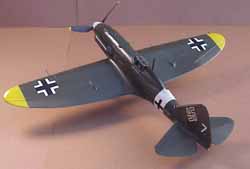 The cockpit location is a bit vague, but the floor should actually slope downwards as it moves to the rear of the airframe, it's not level. Mind the rudder pedals supplied in the kit, dump them. All Re-2005s had a rudder bar, as did Mc-200,Mc-202, etc. Don't know how the master maker could have botched that one.
The cockpit location is a bit vague, but the floor should actually slope downwards as it moves to the rear of the airframe, it's not level. Mind the rudder pedals supplied in the kit, dump them. All Re-2005s had a rudder bar, as did Mc-200,Mc-202, etc. Don't know how the master maker could have botched that one. Is it me or are the main wheels a bit small? They are a bit wide to fit in the main gear stirrups; some thinning of the inside of the gear forks will be necessary.
Is it me or are the main wheels a bit small? They are a bit wide to fit in the main gear stirrups; some thinning of the inside of the gear forks will be necessary.